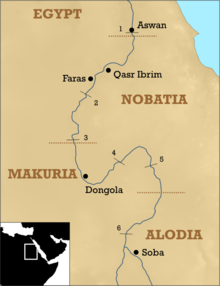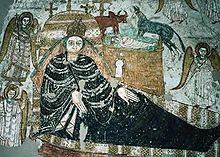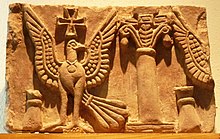Faras: Difference between revisions
mNo edit summary |
→Archaeology: Number concordance, assuming they meant 'a major pottery workshop was found' |
||
| Line 50: | Line 50: | ||
==Archaeology== |
==Archaeology== |
||
One of the most important discoveries from the Christian period was [[Faras Cathedral|the town's cathedral]]. The cathedral had been completely filled with sand which preserved a large number of intricate paintings on its walls. These paintings are the best surviving examples of Christian Nubian art and depict portraits of various monarchs and bishops of Faras, Christian saints and a number of well-known Biblical scenes. These paintings were salvaged and are today on display in the Polish [[National Museum, Warsaw|National Museum]] in Warsaw, and in [[National Museum of Sudan|Sudan National Museum]] in [[Khartoum]]. In addition, a major pottery |
One of the most important discoveries from the Christian period was [[Faras Cathedral|the town's cathedral]]. The cathedral had been completely filled with sand which preserved a large number of intricate paintings on its walls. These paintings are the best surviving examples of Christian Nubian art and depict portraits of various monarchs and bishops of Faras, Christian saints and a number of well-known Biblical scenes. These paintings were salvaged and are today on display in the Polish [[National Museum, Warsaw|National Museum]] in Warsaw, and in [[National Museum of Sudan|Sudan National Museum]] in [[Khartoum]]. In addition, a major pottery workshop was found. |
||
In the turbulent later years of Christian Nubia, Faras seems to have declined and the administrative centre moved to the more easily defended area of [[Qasr Ibrim]]. |
In the turbulent later years of Christian Nubia, Faras seems to have declined and the administrative centre moved to the more easily defended area of [[Qasr Ibrim]]. |
||
Revision as of 08:45, 22 June 2020
 Faras' position within Nubia (upper left) | |
| Location | Sudan |
|---|---|
| Region | Northern State |
| Coordinates | 22°12′N 31°28′E / 22.200°N 31.467°E |
Faras (formerly Ancient Greek: Παχώρας, Pakhôras; Latin: Pachoras; Old Nubian: Ⲡⲁⲭⲱⲣⲁⲥ, Pakhoras[1]) was a major city in Lower Nubia. The site of the city, on the border between modern Egypt and Sudan at Wadi Halfa Salient, was flooded by Lake Nasser in the 1960s and is now permanently underwater. Before this flooding, extensive archaeological work was conducted by a Polish archaeological team led by professor Kazimierz Michałowski.


History

Dating back to the A-Group period, the town was a major centre during the Meroitic period, and was the site of a major temple. During the period of ancient Egyptian control over Nubia, Faras became an Egyptian administrative centre and, located upriver from Abu Simbel, Egyptian cultural influences were prominent.
The city reached its height during the Christian period of Nubia, when Faras was the capital of the Basiliskos Silko of Nobadia. When Nobatia was absorbed into Makuria, it remained the most prominent center in the north, the seat of Nobadia's eparch.
Archaeology
One of the most important discoveries from the Christian period was the town's cathedral. The cathedral had been completely filled with sand which preserved a large number of intricate paintings on its walls. These paintings are the best surviving examples of Christian Nubian art and depict portraits of various monarchs and bishops of Faras, Christian saints and a number of well-known Biblical scenes. These paintings were salvaged and are today on display in the Polish National Museum in Warsaw, and in Sudan National Museum in Khartoum. In addition, a major pottery workshop was found.
In the turbulent later years of Christian Nubia, Faras seems to have declined and the administrative centre moved to the more easily defended area of Qasr Ibrim.
See also
References
- ^ "TM Places". www.trismegistos.org. Retrieved 2020-03-21.
External links
- Faras Gallery in the National Museum in Warsaw
- Exhibition on Faras, Vienna 2002
- Medieval Nubia

